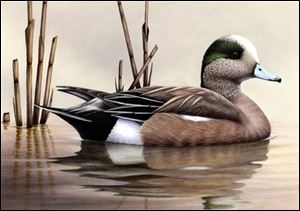
Maryland man's art will grace next year's duck stamp
10/27/2009
Robert Bealle from Waldorf, Md., created this portrait of a drake, or male, American wigeon. He won first place out of 224 entries.
A rendering of a drake, or male, American wigeon will grace the 2010-2011 federal duck stamp as a result of the recent, prestigious annual art competition, which draws the nation's top wildlife artists.
Robert Bealle, an artist from Waldorf, Md., took top honors with the wigeon among 224 entries in the contest. The U.S. Fish & Wildlife Service annually produces the stamp, which sells for $15 and raises about $25 million annually for wetland habitat acquisition for the national wildlife refuge system.
Scot Storm of Freeport, Minn., placed second with an acrylic painting of a pair of wood ducks, and Jeffrey Mobley of Tulsa, Okla., took third place with an acrylic of a gadwall.
"The magnitude of this moment has not escaped me," said Bealle, who has previously entered the Duck Stamp Contest numerous times. "I'm so humbled and appreciative of this. I just don't know what to say." The winning artist is all but guaranteed millionaire status with the attendant notoriety and prints.
The wigeon, some of which migrate through the western Lake Erie region, is a bird of open wetlands, such as wet grassland or marshes with some taller vegetation. It usually feeds by dabbling for plant food or grazing.
The species nests on the ground, near water, and under cover. It lays six to 12 creamy white eggs. Flocks may often contain American coots or mud hens. It is a noisy species, the drake uttering a clear, three-syllable whistle, whoee-whoe-whoe and the female issuing what is characterized as a low growl qua-ack. Its continental population has been stable at long-term averages in recent years.
All waterfowl hunters age 16 and older are required to purchase and carry the current Migratory Bird Conservation and Hunting Stamp - commonly known as the duck stamp - but conservationists, stamp collectors, and others also purchase the stamp in support of habitat conservation. Ninety-eight percent of the proceeds from the $15 Duck Stamp go to the Migratory Bird Conservation Fund.
Since 1934, the federal duck stamp program has raised more than $750 million to purchase nearly six million acres of wildlife habitat for the Refuge System.
To date, duck stamp funds have been used to acquire habitat at hundreds of refuges, in nearly every state in our nation. There are 550 national wildlife refuges spread across all 50 states and U.S. territories. A current stamp can be used for free admission to any national wildlife refuge open to the public.
•
It has taken some 20 years of dedicated effort, but the field researchers of the Black Swamp Bird Observatory at Oak Harbor have reached a milestone, banding their 500,000th bird.
"The milestone was reached this fall, and our star bird was a blackpoll warbler; the tiny champion of migration," said Kim Kaufman, BSBO's executive director. "This milestone represents so many great things - not just for BSBO - but for this entire area."
Indeed, the BSBO banding station, along the western Lake Erie shoreline near Davis-Besse in western Ottawa County, is in the heartland of a major migratory corridor for North America.
Over the years BSBO has banded scores and scores of species, from bald eagles to tiny flycatchers. Banding is an important field tool, helping researchers to learn over time - via live recaptures or recoveries of deceased, banded individuals - the movements and distribution of various species.
Birds typically are captured in forgiving mist nets, metal legbands are affixed, and the birds are released unharmed.
In other BSBO news, the Ohio Young Birders Club is hosting its annual conference Nov. 14, from 8:30 a.m. to 4:30 p.m., at the Ottawa National Wildlife Refuge visitor center, 14000 West State Rt. 2, Oak Harbor.
Founded by BSBO, the youth contingent also sponsors monthly field trips around Ohio and is fast becoming a model for programs elsewhere. This year, 17-year-old Malkolm Boothroyd of Whitehorse, Yukon, Canada, is keynote speaker on "A Big Year and Bird Conservation."
A birder since age seven, Malkolm has found ways to combine conservation efforts with birdwatching. Last year he and his family bicycled 13,000 miles to see how many birds they could see, in what birders refer to as a "Big Year," and collected "per-bird pledges" to raise money for conservation. Twelve months and 548 birds later, they had succeeded in raising over $25,000.
An afternoon field trip on the Ottawa refuge also is planned. Breakfast and lunch are included. For details and to register visit bsbobird.org or call BSBO at 419-898-4070.
•
Doug Brewer, manager of the Ottawa National Wildlife Refuge, and representatives from refuges in New Jersey and Colorado are set to meet Friday at 7 p.m. with current and prospective volunteers to explore ways to be involved with and support the refuge.
Volunteers can assist with projects ranging from visitor reception to environmental education to wildlife habitat improvement. Nationwide there are more that 240 refuge support groups.
The local volunteers, known as the Ottawa NWR Association, was founded in 1999. The meeting is set for the refuge visitor center.
Speakers include Kathy Woodward, a volunteer at Great Swamp National Wildlife Refuge in New Jersey and Mike Blenden, manager of the San Luis Valley Refuges in Colorado. For other details call the refuge at 419-898-0014 or visit online at onwra.com.
Contact Steve Pollick at:
spollick@theblade.com
or 419-724-6068.w